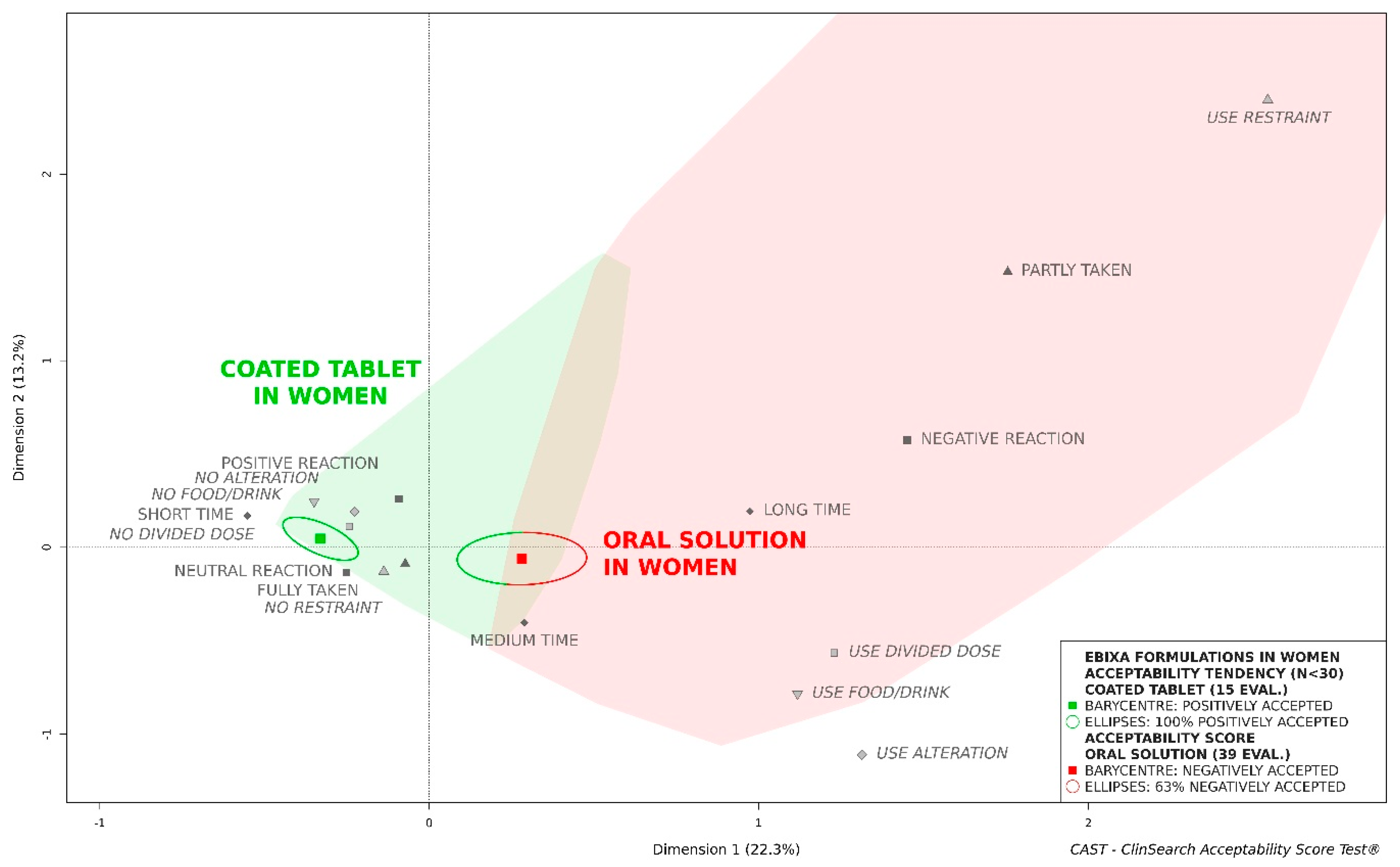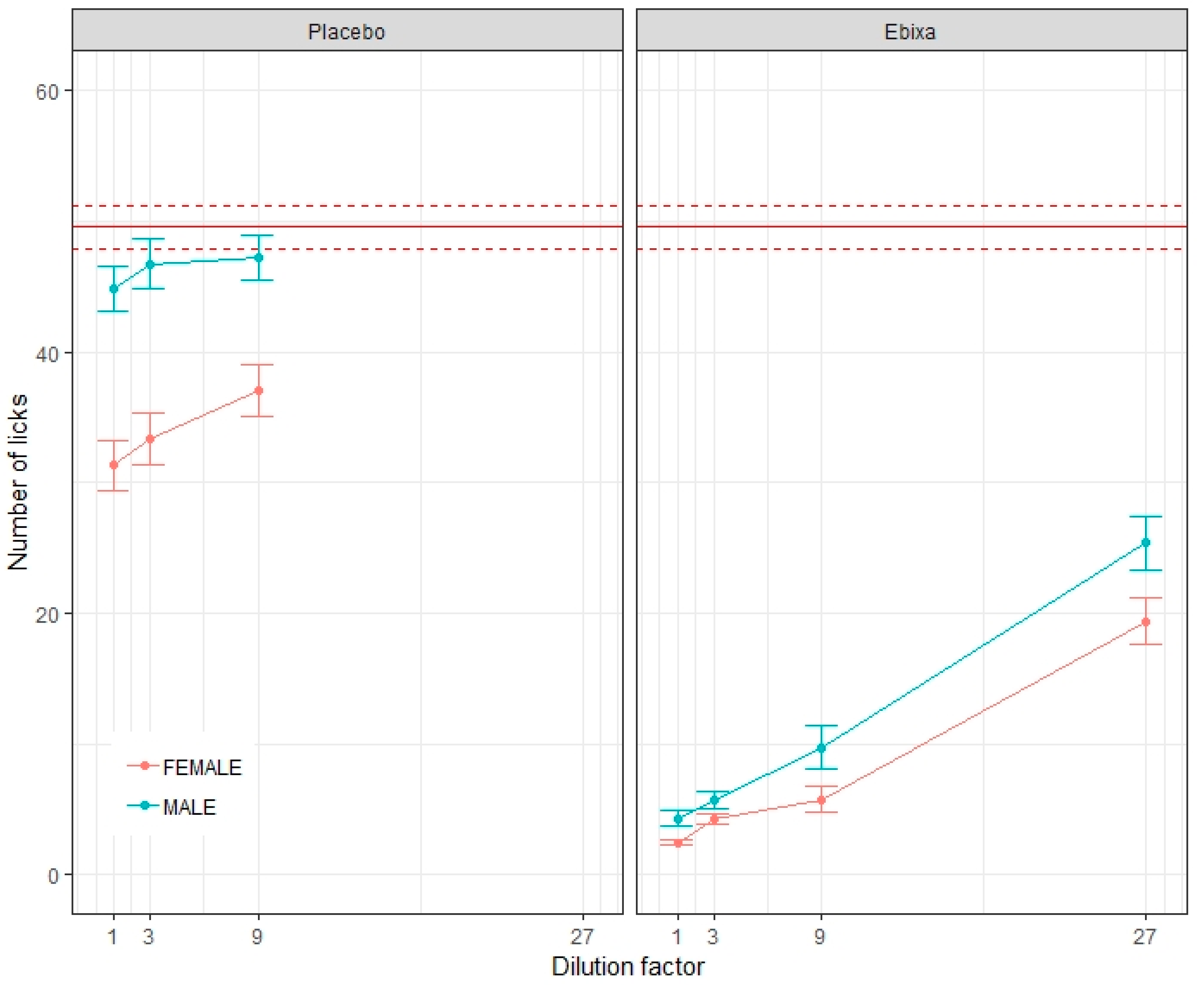Sex Differences in Medicine Acceptability: A New Factor to Be Considered in Medicine Formulation
Abstract
:1. Introduction
2. Materials and Methods
2.1. Acceptability Study in Older Adults
2.1.1. Data Source
2.1.2. Data Analysis
2.2. Aversiveness Study in Animals
2.2.1. Test Solutions
2.2.2. Data Collection
2.2.3. Data Analysis
3. Results
3.1. Acceptability Study in Older Adults
3.1.1. Patient Characteristics
3.1.2. Acceptability of the Original Formulations of Memantine
3.1.3. Sex Differences
3.2. Aversiveness Study in Animals
3.2.1. Aversiveness of Test Solutions
3.2.2. Sex Differences
4. Discussion
5. Conclusions
Supplementary Materials
Author Contributions
Funding
Acknowledgments
Conflicts of Interest
References
- Burkhart, P.V.; Sabate, E. Adherence to long-term therapies: Evidence for action. J. Nurs. Sch. 2003, 35, 207. [Google Scholar]
- Viswanathan, M.; Golin, C.E.; Jones, C.D.; Ashok, M.; Blalock, S.J.; Wines, R.C.; Coker-Schwimmer, E.J.; Rosen, D.L.; Sista, P.; Lohr, K.N. Interventions to improve adherence to self-administered medications for chronic diseases in the United States: A systematic review. Ann. Intern. Med. 2012, 157, 785–795. [Google Scholar] [CrossRef] [PubMed]
- Khan, R.; Socha-Dietrich, K. Investing in Medication Adherence Improves Health Outcomes and Health System Efficiency; OECD: Paris, France, 2018. [Google Scholar]
- European Medicine Agency. Guideline on Pharmaceutical Development of Medicines for Paediatric Use; European Medicines Agency: London, UK, 2013. [Google Scholar]
- Mennella, J.A.; Spector, A.C.; Reed, D.R.; Coldwell, S.E. The bad taste of medicines: Overview of basic research on bitter taste. Clin. Ther. 2013, 35, 1225–1246. [Google Scholar] [CrossRef] [PubMed]
- Mojet, J.; Christ-Hazelhof, E.; Heidema, J. Taste perception with age: Generic or specific losses in threshold sensitivity to the five basic tastes? Chem. Senses 2001, 26, 845–860. [Google Scholar] [CrossRef] [PubMed]
- Imoscopi, A.; Inelmen, E.M.; Sergi, G.; Miotto, F.; Manzato, E. Taste loss in the elderly: Epidemiology, causes and consequences. Aging Clin. Exp. Res. 2012, 24, 570–579. [Google Scholar] [PubMed]
- Syed, Q.; Hendler, K.T.; Koncilja, K. The impact of aging and medical status on dysgeusia. Am. J. Med. 2016, 129, 753.e1–753.e6. [Google Scholar] [CrossRef]
- Stegemann, S.; Gosch, M.; Breitkreutz, J. Swallowing dysfunction and dysphagia is an unrecognized challenge for oral drug therapy. Int. J. Pharm. 2012, 430, 197–206. [Google Scholar] [CrossRef]
- Vallet, T.; Belissa, E.; Laribe-Caget, S.; Chevallier, A.; Chedhomme, F.X.; Leglise, P.; Piccoli, M.; Michelon, H.; Bloch, V.; Meaume, S.; et al. A Decision Support Tool Facilitating Medicine Design for Optimal Acceptability in The Older Population. Pharm. Res. 2018, 35, 136. [Google Scholar] [CrossRef]
- Ruiz, F.; Vallet, T.; Pense-Lheritier, A.M.; Aoussat, A. Standardized method to assess medicines’ acceptability: Focus on paediatric population. J. Pharm. Pharmacol. 2017, 69, 406–416. [Google Scholar] [CrossRef]
- Cochran, W. Some Methods for Strengthening the Common χ2 Tests. Biometrics 1954, 10, 417–451. [Google Scholar] [CrossRef]
- Le, S.; Josse, J.; Husson, F. FactoMineR: An R package for multivariate analysis. J. Stat. Softw. 2008, 25, 1–18. [Google Scholar] [CrossRef]
- Josse, J.; Husson, F. missMDA: A package for handling missing values in multivariate data analysis. J. Stat. Softw. 2016, 70, 1–31. [Google Scholar] [CrossRef]
- Soto, J. Assessing the Feasibility of Using an Animal Model for In Vivo Taste Assessment of Pharmaceutical Compounds and Formulations. Ph.D. Thesis, UCL (University College London), London, UK, 2016. [Google Scholar]
- Devantier, H.R.; Long, D.J.; Brennan, F.X.; Carlucci, S.A.; Hendrix, C.; Bryant, R.W.; Salemme, F.R.; Palmer, R.K. Quantitative assessment of TRPM5-dependent oral aversiveness of pharmaceuticals using a mouse brief-access taste aversion assay. Behav. Pharmacol. 2008, 19, 673–682. [Google Scholar] [CrossRef] [PubMed]
- Rudnitskaya, A.; Kirsanov, D.; Blinova, Y.; Legin, E.; Seleznev, B.; Clapham, D.; Ives, R.S.; Saunders, K.A.; Legin, A. Assessment of bitter taste of pharmaceuticals with multisensor system employing 3 way PLS regression. Anal. Chim. Acta 2013, 770, 45–52. [Google Scholar] [CrossRef] [PubMed]
- Bhat, M.G.; Jordt, R.M.; Khan, M.A.; Foley, C.E.; Gilbertson, T.A. Validation of a rat behavioral avoidance model from a drug delivery perspective. Int. J. Pharm. 2005, 303, 31–36. [Google Scholar] [CrossRef]
- Soto, J.; Keeley, A.; Keating, A.V.; Mohamed-Ahmed, A.H.; Sheng, Y.; Winzenburg, G.; Turner, R.; Desset-Brèthes, S.; Orlu, M.; Tuleu, C. Rats can predict aversiveness of Active Pharmaceutical Ingredients. Eur. J. Pharm. Biopharm. 2018, 133, 77–84. [Google Scholar] [CrossRef] [PubMed]
- Soto, J.; Sheng, Y.; Standing, J.F.; Orlu Gul, M.; Tuleu, C. Development of a model for robust and exploratory analysis of the rodent brief-access taste aversion data. Eur. J. Pharm. Biopharm. 2015, 91, 47–51. [Google Scholar] [CrossRef] [PubMed] [Green Version]
- Gao, X.; Alvo, M.; Chen, J.; Li, G. Nonparametric multiple comparison procedures for unbalanced one-way factorial designs. J. Stat. Plan. Inference 2008, 138, 2574–2591. [Google Scholar] [CrossRef]
- Hofmanová, J.; Rajabi-Siahboomi, A.; Haque, S.; Mason, J.; Teckoe, J.; To, D.; Batchelor, H. Developing methodology to evaluate the oral sensory features of pharmaceutical tablet coatings. Int. J. Pharm. 2019, 562, 212–217. [Google Scholar] [CrossRef]
- Ranmal, S.R.; O’Brien, F.; Lopez, F.; Ruiz, F.; Orlu, M.; Tuleu, C.; Walsh, J.; Liu, F. Methodologies for assessing the acceptability of oral formulations among children and older adults: A systematic review. Drug Discov. Today 2018, 23, 830–847. [Google Scholar] [CrossRef]
- Arrêté du 29 mai 2018 Portant Radiation de Spécialités Pharmaceutiques de la Liste Mentionnée au Premier Alinéa de L’article L. 162-17 du Code de la Sécurité Sociale|Legifrance. Available online: https://www.legifrance.gouv.fr/eli/arrete/2018/5/29/SSAS1804466A/jo/texte (accessed on 17 April 2019).
- Valenstein, E.S.; Kakolewski, J.W.; Cox, V.C. Sex differences in taste preference for glucose and saccharin solutions. Science 1967, 156, 942–943. [Google Scholar] [CrossRef] [PubMed]
- Tapia, M.A.; Lee, J.R.; Weise, V.N.; Tamasi, A.M.; Will, M.J. Sex differences in hedonic and homeostatic aspects of palatable food motivation. Behav. Brain Res. 2019, 359, 396–400. [Google Scholar] [CrossRef] [PubMed]
- Monneuse, M.O.; Bellisle, F.; Louis-Sylvestre, J. Impact of sex and age on sensory evaluation of sugar and fat in dairy products. Physiol. Behav. 1991, 50, 1111–1117. [Google Scholar] [CrossRef]
- Luck, E. Food applications of sorbic acid and its salts. Food Addit. Contam. 1990, 7, 711–715. [Google Scholar] [CrossRef] [PubMed]
- Aly, M.E. Prolongation of the keeping quality of Mozzarella cheese by treatment with sorbate. Nahrung 1996, 40, 194–200. [Google Scholar] [CrossRef]
- OIV. International Œnological Codex; OIV: Paris, France, 2019. [Google Scholar]
- Schiffman, S.S. Taste and smell losses in normal aging and disease. JAMA 1997, 278, 1357–1362. [Google Scholar] [CrossRef] [PubMed]



| Patient Characteristics | Women | Men | ||
|---|---|---|---|---|
| Coated Tablet (n = 15) | Oral Solution (n = 39) | Coated Tablet (n = 10) | Oral Solution (n = 21) | |
| Age (Years) | ||||
| [65, 75[ | 1 (7) 1 | 4 (10) | 0 (0) | 3 (14) |
| [75, 85[ | 5 (33) | 11 (28) | 3 (30) | 8 (38) |
| [85, 95[ | 9 (60) | 19 (49) | 7 (70) | 10 (48) |
| [95, 104] | 0 (0) | 5 (13) | 0 (0) | 0 (0) |
| Statistical Test | 0.642 (F) 2 | 0.557 (F) | ||
| Disabilities | ||||
| Swallowing disorder | 2 (13) | 5 (13) | 0 (0) | 3 (14) |
| Statistical Test | 1 (F) | 0.533 (F) | ||
| Muscular or rheumatologic disorders of the upper limbs | 2 (13) | 5 (13) | 1 (10) | 3 (14) |
| Statistical Test | 1 (F) | 1 (F) | ||
| Cognitive impairment | 15 (100) | 39 (100) | 10 (100) | 21 (100) |
| Statistical Test | 1 (F) | 1 (F) | ||
| Medicine Exposure | ||||
| Already taken | 15 (100) | 39 (100) | 10 (100) | 21 (100) |
| Number of Prescribed Medicines per Day | ||||
| [1–5[ | 0 (0) | 0 (0) | 1 (10) | 0 (0) |
| [5–10[ | 4 (27) | 24 (62) | 3 (30) | 8 (38) |
| ≥10 | 11 (73) | 15 (38) | 6 (60) | 13 (62) |
| Statistical Test | 0.033 (F) | 0.490 (F) | ||
| Test Solutions | Water | Ebixa | Ebixa 3FD | Ebixa 9FD | Ebixa 27FD | Placebo | Placebo 3FD | Placebo 9FD |
|---|---|---|---|---|---|---|---|---|
| Water | NA | <0.001 | <0.001 | <0.001 | <0.001 | <0.001 | <0.001 | <0.001 |
| Ebixa | <0.001 | NA | 0.013 | <0.001 | <0.001 | <0.001 | <0.001 | <0.001 |
| Ebixa 3FD | <0.001 | 0.025 | NA | 0.048 | <0.001 | <0.001 | <0.001 | <0.001 |
| Ebixa 9FD | <0.001 | <0.001 | 0.048 | NA | <0.001 | <0.001 | <0.001 | <0.001 |
| Ebixa 27FD | <0.001 | <0.001 | <0.001 | <0.001 | NA | <0.001 | <0.001 | <0.001 |
| Placebo | <0.001 | <0.001 | <0.001 | <0.001 | <0.001 | NA | 0.44 | 0.14 |
| Placebo 3FD | <0.001 | <0.001 | <0.001 | <0.001 | <0.001 | 0.44 | NA | 0.44 |
| Placebo 9FD | <0.001 | <0.001 | <0.001 | <0.001 | <0.001 | 0.14 | 0.33 | NA |
| Males vs. Females | 0.12 | <0.001 | 0.35 | 0.008 | 0.032 | <0.001 | <0.001 | <0.001 |
© 2019 by the authors. Licensee MDPI, Basel, Switzerland. This article is an open access article distributed under the terms and conditions of the Creative Commons Attribution (CC BY) license (http://creativecommons.org/licenses/by/4.0/).
Share and Cite
Ruiz, F.; Keeley, A.; Léglise, P.; Tuleu, C.; Lachuer, C.; Rwabihama, J.-P.; Bachalat, N.; Boulaich, I.; Abdallah, F.; Rabus, M.; et al. Sex Differences in Medicine Acceptability: A New Factor to Be Considered in Medicine Formulation. Pharmaceutics 2019, 11, 368. https://doi.org/10.3390/pharmaceutics11080368
Ruiz F, Keeley A, Léglise P, Tuleu C, Lachuer C, Rwabihama J-P, Bachalat N, Boulaich I, Abdallah F, Rabus M, et al. Sex Differences in Medicine Acceptability: A New Factor to Be Considered in Medicine Formulation. Pharmaceutics. 2019; 11(8):368. https://doi.org/10.3390/pharmaceutics11080368
Chicago/Turabian StyleRuiz, Fabrice, Alexander Keeley, Patrick Léglise, Catherine Tuleu, Célia Lachuer, Jean-Paul Rwabihama, Nathalie Bachalat, Imad Boulaich, Fattima Abdallah, Maité Rabus, and et al. 2019. "Sex Differences in Medicine Acceptability: A New Factor to Be Considered in Medicine Formulation" Pharmaceutics 11, no. 8: 368. https://doi.org/10.3390/pharmaceutics11080368
APA StyleRuiz, F., Keeley, A., Léglise, P., Tuleu, C., Lachuer, C., Rwabihama, J.-P., Bachalat, N., Boulaich, I., Abdallah, F., Rabus, M., Ribemont, A.-C., Michelon, H., Wojcicki, A. D., Orlu, M., Vallet, T., & Boudy, V. (2019). Sex Differences in Medicine Acceptability: A New Factor to Be Considered in Medicine Formulation. Pharmaceutics, 11(8), 368. https://doi.org/10.3390/pharmaceutics11080368








